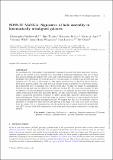Files in this item
SDSS-IV MaNGA : signatures of halo assembly in kinematically misaligned galaxies
Item metadata
| dc.contributor.author | Duckworth, Christopher | |
| dc.contributor.author | Tojeiro, Rita | |
| dc.contributor.author | Kraljic, Katarina | |
| dc.contributor.author | Sgró, Mario A. | |
| dc.contributor.author | Wild, Vivienne | |
| dc.contributor.author | Weijmans, Anne-Marie | |
| dc.contributor.author | Lacerna, Ivan | |
| dc.contributor.author | Drory, Niv | |
| dc.date.accessioned | 2018-11-19T16:30:11Z | |
| dc.date.available | 2018-11-19T16:30:11Z | |
| dc.date.issued | 2019-02-11 | |
| dc.identifier | 256624783 | |
| dc.identifier | 8f2406b1-fe7e-4e3e-ae16-6055308d667a | |
| dc.identifier | 000462251000011 | |
| dc.identifier | 85068923918 | |
| dc.identifier.citation | Duckworth , C , Tojeiro , R , Kraljic , K , Sgró , M A , Wild , V , Weijmans , A-M , Lacerna , I & Drory , N 2019 , ' SDSS-IV MaNGA : signatures of halo assembly in kinematically misaligned galaxies ' , Monthly Notices of the Royal Astronomical Society , vol. 483 , no. 1 , pp. 172–188 . https://doi.org/10.1093/mnras/sty3101 | en |
| dc.identifier.issn | 0035-8711 | |
| dc.identifier.other | BibCode: 2018arXiv181106408D | |
| dc.identifier.other | ORCID: /0000-0002-5908-6852/work/51010300 | |
| dc.identifier.uri | https://hdl.handle.net/10023/16504 | |
| dc.description | Funding: RT acknowledges support from the Science and Technology Facilities Council via an Ernest Rutherford Fellowship (grant number ST/K004719/1). VW acknowledges support of the European Research Council via the award of a starting grant (SED-Morph; P.I. V. Wild). | en |
| dc.description.abstract | We investigate the relationship of kinematically misaligned galaxies with their large-scale environment, in the context of halo assembly bias. According to numerical simulations, halo age at fixed halo mass is intrinsically linked to the large-scale tidal environment created by the cosmic web. We investigate the relationship between distances to various cosmic web features and present-time gas accretion rate. We select a sub-sample of ∼900 central galaxies from the MaNGA survey with defined global position angles (PA; angle at which velocity change is greatest) for their stellar and Hα gas components up to a minimum of 1.5 effective radii (Re). We split the sample by misalignment between the gas and stars as defined by the difference in their PA. For each central galaxy we find its distance to nodes and filaments within the cosmic web, and estimate the host halo’s age using the central stellar mass to total halo mass ratio M*/Mh. We also construct halo occupation distributions using a background subtraction technique for galaxy groups split using the central galaxy’s kinematic misalignment. We find, at fixed halo mass, no statistical difference in these properties between our kinematically aligned and misaligned galaxies. We suggest that the lack of correlation could be indicative of cooling flows from the hot halo playing a far larger role than ‘cold mode’ accretion from the cosmic web or a demonstration that the spatial extent of current large-scale integral field unit (IFU) surveys hold little information about large-scale environment extractable through this method. | |
| dc.format.extent | 1579943 | |
| dc.language.iso | eng | |
| dc.relation.ispartof | Monthly Notices of the Royal Astronomical Society | en |
| dc.subject | Cosmology: dark matter | en |
| dc.subject | Cosmology: large-scale s | en |
| dc.subject | Galaxies: evolution | en |
| dc.subject | Galaxies: haloes | en |
| dc.subject | Galaxies: kinematics and dynamics | en |
| dc.subject | QB Astronomy | en |
| dc.subject | QC Physics | en |
| dc.subject | 3rd-NDAS | en |
| dc.subject.lcc | QB | en |
| dc.subject.lcc | QC | en |
| dc.title | SDSS-IV MaNGA : signatures of halo assembly in kinematically misaligned galaxies | en |
| dc.type | Journal article | en |
| dc.contributor.sponsor | Science & Technology Facilities Council | en |
| dc.contributor.sponsor | European Research Council | en |
| dc.contributor.institution | University of St Andrews. School of Physics and Astronomy | en |
| dc.identifier.doi | 10.1093/mnras/sty3101 | |
| dc.description.status | Peer reviewed | en |
| dc.identifier.url | http://adsabs.harvard.edu/abs/2018arXiv181106408D | en |
| dc.identifier.grantnumber | ST/K004719/1 | en |
| dc.identifier.grantnumber | ERC-2012-StG-20111012 | en |
This item appears in the following Collection(s)
Items in the St Andrews Research Repository are protected by copyright, with all rights reserved, unless otherwise indicated.

